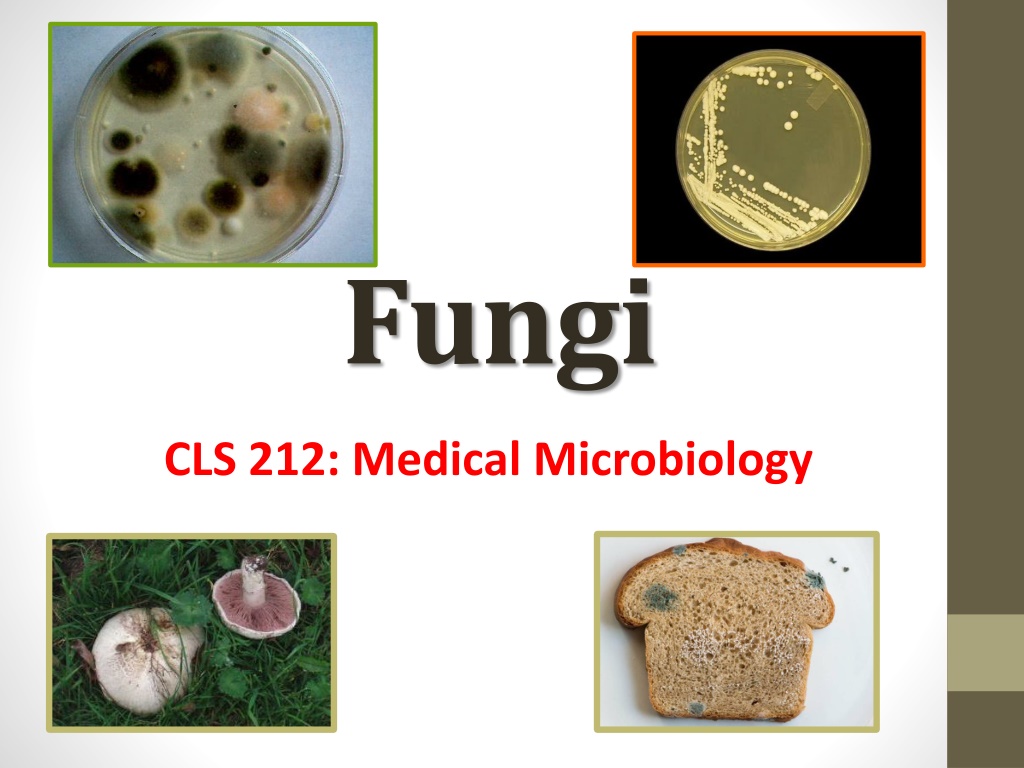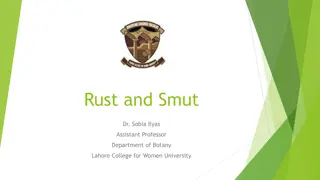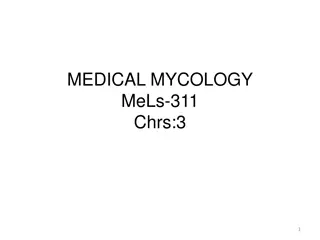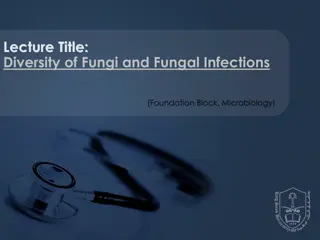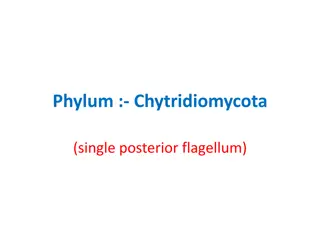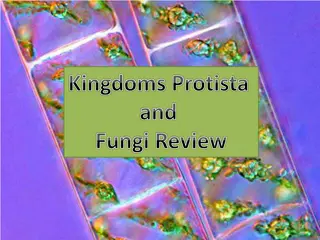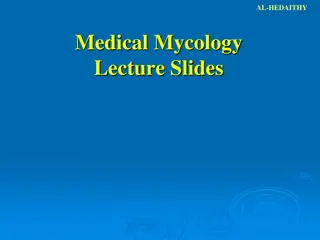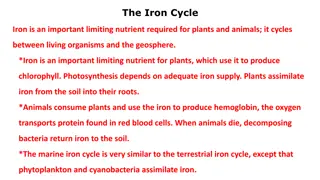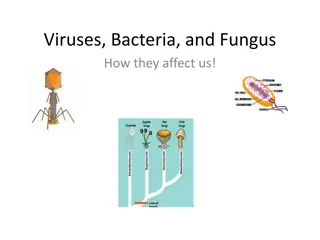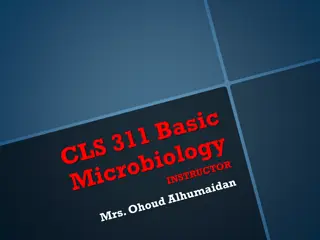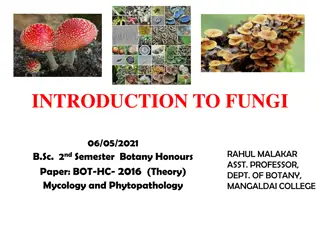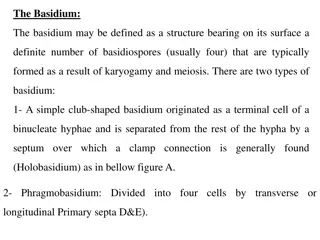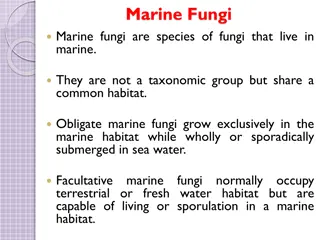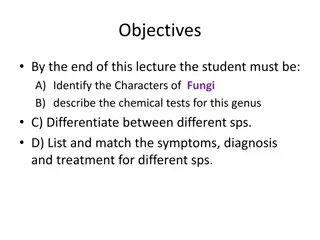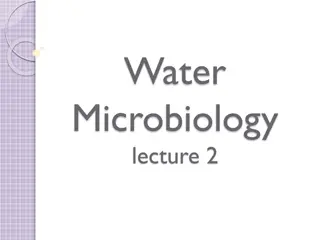The Fascinating World of Fungi in Medical Microbiology
Fungi are eukaryotic organisms with diverse characteristics and roles in nature. They are essential for the ecosystem, being heterotrophic and distinct from plants. In medical microbiology, fungi play crucial roles, such as in the production of antibiotics and foods like cheese. The classification, structure, and reproduction of fungi are explored, highlighting their importance and complexity in various environments.
Download Presentation

Please find below an Image/Link to download the presentation.
The content on the website is provided AS IS for your information and personal use only. It may not be sold, licensed, or shared on other websites without obtaining consent from the author.If you encounter any issues during the download, it is possible that the publisher has removed the file from their server.
You are allowed to download the files provided on this website for personal or commercial use, subject to the condition that they are used lawfully. All files are the property of their respective owners.
The content on the website is provided AS IS for your information and personal use only. It may not be sold, licensed, or shared on other websites without obtaining consent from the author.
E N D
Presentation Transcript
Fungi CLS 212: Medical Microbiology
Introduction Mycology All fungi are Eukaryotic organisms living everywhere on earth. Fungi are Heterotrophic i.e. depend on other organism for food and are different from plants which are Autotrophic
General Characteristics of Fungi Heterotrophic organisms are 3 kinds: A)Saprophytic B)Symbiotic C) Parasitic
General Characteristics of Fungi Beneficial fungi are important in the production of cheeses and other foods . fungi are important in the production of antibiotics e.g. Penicillin. fungi causing deterioration of leather , plastic and spoilage of jams and pickles.
Plant vs. fungi They are not plants ( page 75 ) PLANT FUNGUS Autotrophic Heterotrophic FOOD PIGMENTS CELL WALL
Structure of Fungi Fungi can be Unicellular = Yeasts Multicellular = Molds
Reproduction Depending on the species : Some fungi produce both sexual and asexual spores budding Hyphal extension Spore formation >>>> a- sexual spores (conidia) b- asexual spores
Mold Important term : ( page 75) Hypha Hyphae Septate hyphae Aseptate hyphae Mycelium
Molds Molds are multicellular fungi which are more complex than yeasts. The fungus form microscopic tubes or filaments called hyphae that contain cytoplasm & nuclei. Hyphae can be: Septate hyphae Non-septate hyphae
Molds Reproduction of Molds Molds reproduce by spore formation, either sexually or asexually. Uses of Molds Penicillium used to produce the antibiotic penicillin. Some molds are used to produce enzymes and organic acids. For the production of different cheeses e.g. Blue cheese,
yeast Yeasts are single-celled fungi (unicellular) that can only be seen under microscope . Yeast are found in soil , water and on the skin of many fruits . Shape of Yeasts a) True yeasts: Cell retain individually. b) Psuedohyphae: Elongated yeast cells attach to each other side by side forming a structure that looks like hyphae.
yeast Reproduction of Yeasts Usually yeasts reproduce by Budding but some by spore formation. Examples of Yeasts Saccharomyces cerevisiae live on the skin of grapes and other fruits are responsible for the fermentation process of these fruits. This fungi is also used as Baker s Yeast in baking and bread production. Candida albicansandCryptococcus neoformans are human pathogens.
Fungi can be: 1. Monomorphic Fungi that has only one shape or morphology. e.g. Cladosporium bantianum Aspergillus fumigatus 2. Dimorphic (Diphasic) ( see page 81) Many dimorphic fungi are pathogenic but not all the pathogenic fungi are dimorphic. e.g.Histoplasma Blastomyces *Not : Fleshy fungi? ( page 79 )
e.g. Histoplasma At room temperature ( 25C) At 37C
Reproduction of Fungi Fungi can reproduce by two different ways: 1. Asexual reproduction. 1. Sexual reproduction
I- Asexual Reproduction Multiplying multiple copies of the same organism only by Mitosis. 1. Somatic:in yeasts reproduce by Budding in molds reproduce by HyphaFragmentation 2. Spore Formation:the end product is spore. . Budding in yeast
I- Asexual Reproduction Types of Asexuall Spore Formation: a. Sporangiosporesin sporangium. b. Chlamydosporesin or on hyphae thick walled, resistant spore, terminal. c. Conidiaon hypha or on conidiophores
Conidia have many types: 1. Blastospore 1. Arthospore 1. Aleuriospore
II- Sexual Reproduction Sexual Reproduction happen by 3 stages: 1. fusion 2. mitosis 3.miosis Types of Sexual Spores: 1. Oospore 2. Zygospore 3. Ascospore 4. Basidoispore zygospore Ascospre Basidiospore
Deuteromycetes (Imperfect Fungi = Fungi Imperfecti) Aphylum of fungi that are without sexual stage in their life cycle , reproducing only by asexual spores. Also called imperfecti because their life cycles are imperfect.
Fungal infections 1. Superficial mycosis: Piedra. 2. Coetaneous mycosis: Dermatophytes. 3. Subcutaneous mycosis. 4. Systemic mycosis. 5. Opportunistic mycosis: Candidosis.
Superficial Mycosis:Piedra Fungul infections of the outer most area in the human body Effect: the outer most layer of the skin (epidermis) and Hair shaft .
- Pityriasis versicolor * it is a chronic superficial infection infecting the dead tissue of the stratum corneum (skin) Lesions occur on the trunk, shoulders and arms, rarely on the neck and face Etiological agent is : Malassezia furfur (yeast)
White Piedra Soft, less firm nodules around hair shaft White to yellowish cream in color. Etiological agent:Trichosporon beigelii. Imperfect yeast cells. Produce cream and beige colonies. Grows fast in culture, very common in KSA. Treatment 1- Cream: 2% salicylic acid 3% sulfur ointment 2- Shampoo: Nizoral which contain ketoconazole. 3- Shave or Cut the hair: then clean the scalp with mild fungicidal.
Coetaneous Mycosis: Dermatophytes Affect all keratinized tissue: Hair, Nail and Skin. Common in children especially school age (2-12years). Symptoms: Skin lesions called Tinea (or Ring worm). The lesion is scaly and cause itching. The margins are red or gray containing active fungus. In the beginning it is mild then it cause toxic reaction of the skin. Transmission of infection: 1-By using personal stuff (e.g. Clothes). 2-House pets (cats and dogs). 3-Common in livestock animals (horses, sheep, and cows). 4-From the soil.
The Clinical Types of Dermatophytes Tinea exists in any part of the body depending on the location it is given a different name: Athlete's foot or Tinea pedis Ringworm of the body or Tinea corpora Scalp ringworm or Tinea capitis Ringworm of the nail, Onychomycosis, or Tinea unguium
Opportunistic Mycosis: Candidosis It is any infection caused by species of the fungus Candida. It is usually opportunistic but there are some forms are not. 1- Oral Thrush Infection of the mouth surface by candida Very common in: AIDS patients, young babies, new born, and children. Also it can occur in adults and very old people. Lesion: White patches in the tongue and oral surfaces.
2- Diaper or Napkin rash Common in: Babies who their mothers do not change their diaper frequently. Symptoms:Red area in groin area. It may spread by the baby himself from the groin area to the face part . It usually goes away by correct conditions. 3- Vaginitis Infection of vaginal mucosa by candida. Symptoms: itching, white or yellowish discharges from vaginal surface or pus. 60% of the vaginal discharge is caused by candida. It is very common in KSA. It is more in pregnant and diabetic ladies.
